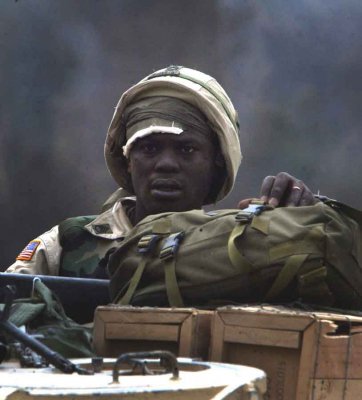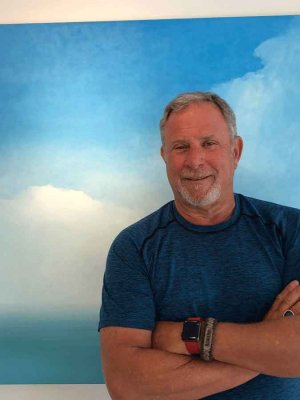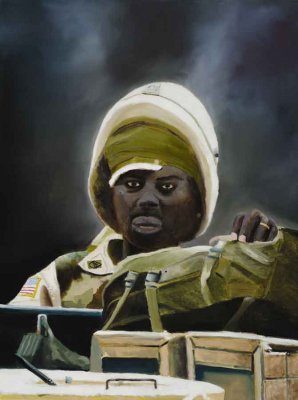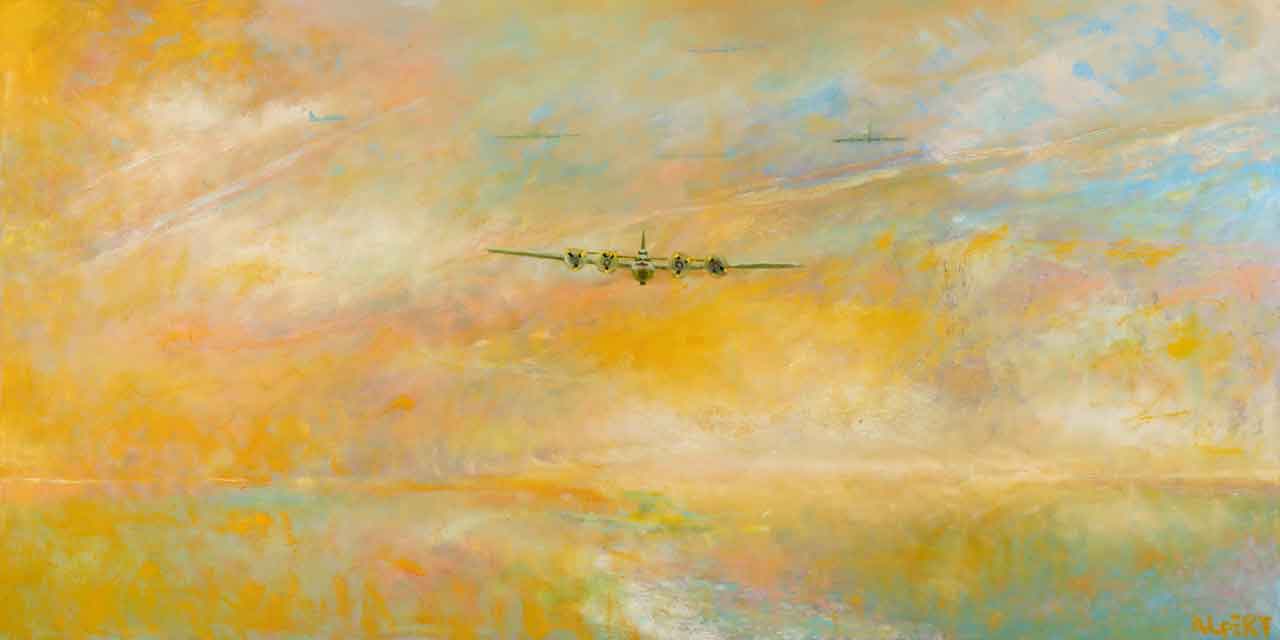A Portrait of a Soldier—Inside Those Lines Was the Story of War
A pop-up box appeared on the screen one night in 2006 as I idly surfed the internet. Thirty-nine dollars and 95 cents would send a care package to an American soldier in Iraq. I typed in my credit card number.
Weeks later I received a thank-you note from the U.S. Army veteran who’d coordinated the effort, along with two CDs full of photographs taken by soldiers in Iraq. One was marked “copywritten” and the other “copyright free.” I concentrated on the “copyright-free” CD.
Among images of street life in Iraq, life inside the wire, combat scenes, and grisly after-action shots that still burn in my head, one photo stood out: a U.S. Army sergeant with a thousand-yard stare.

The original photograph of “Sarge” the author received in 2006 after sending a care package to a soldier in Iraq. Photo courtesy of the author.
I couldn’t stop looking.
An artist by profession, I decided to make 10 paintings from the CD, including the soldier whom I would come to call “Sarge.” Years earlier, my wife and young son had given me that same moniker, saying I barked orders like a drill sergeant.
Life is filled with ironies.
Sarge haunted me. He challenged me. I had never before painted a portrait. Sarge dared me to take on the task. I feared I didn’t have the skill to do him justice. I feared him. Weeks passed. Months. Finally, I drew the image from the photo, getting the lines down. Still, I couldn’t paint him. I stalled and stalled. Then I shoved the canvas behind a stack of canvases in the corner of my studio. Maybe with Sarge hidden, he’d leave me alone. But I knew exactly where I’d stashed it. Sarge was impossible to forget.
Then one day, something ridiculous happened. Sarge started talking smack. Insulting me. He called me a coward, and way worse. He got really rough. And he didn’t just do it when I was in the studio. He tagged along wherever I went. Two hundred miles away in upstate New York, I could hear him, hammering away, calling me names, daring me to paint him. Telling me I couldn’t do it. Chicken shit motherfucker. Pussy-ass-lower-than-dog-doo-no-account-no-talent loser, I heard him say. And worse.

The author procrastinated for more than a year before painting a portrait of the man he would refer to only as “Sarge.”
Sarge was relentless. Back in the studio, I moved the canvas again, this time behind a bunch of other canvases on the other side of the studio. It made no difference. He kept coming after me. Months passed. A year.
Finally, I relented. “OK SARGE!” I announced, fishing out the canvas and sticking it on the easel. Sarge would have his day.
We began. He shut up and I got to work. The face, the helmet, the uniform, the gold wedding band, the eyes—the thousand-yard stare. A head wound. What had happened? How bad was it? Not that serious, it seemed. But that stare …
I went back to the wedding band. A wife back home. Kids? They worried about him, he worried about them. Sarge worried about his men, too, getting them into battle, accomplishing the mission, and getting them all out. He was a Black man fighting for his country, a country that had undoubtedly not always treated him with the respect due to every American.
Smoke filled the background of the photograph. Had Sarge and his men just exited a battle? Was it a burn pit? Was he done for the day, or were he and his platoon going back out—now, tonight, tomorrow? Was he career Army? A short timer? I never knew any more than what the photo told. Except that I had connected with him in a powerful way. And the stare. That look that said maybe he’d seen things he wished he hadn’t. As I painted, I considered all of this. I thought about the things you can know about a person you’ve never met.
Award-Winning Journalism in Your Inbox
Weeks later, I gave it the final brushstrokes. Sarge was done. The first portrait I’d ever attempted. There would be more over the years, a couple of dozen at least. But for now, it was just Sarge and me. I signed the painting and gave it a title: Portrait of a Solder.

Portrait of a Soldier, by Steve Alpert. A photo of an unidentified Army sergeant would be the first portrait the author ever painted.
As I backed away, a wave of emotion took hold of me. “I got you, motherfucker,” I said to him from across the studio. I’d answered his challenge. We were bonded for life. I hadn’t thought I was capable, and neither had he. But there he was, looking out from the canvas telling his story and leaving it to us to guess what it is.
In that moment of celebration, the portrait of Sarge suddenly became bigger than just me and him. Inside those lines was the story of war, of those who serve, of their families. It was a story of the troops who make it home and the loved ones who greet them, of those who make the ultimate sacrifice, and the families who receive a life-altering knock on the door. I began to cry.
I thought of all the men and women who went to war throughout human history. The maiming and the killing of women, men, children, animals, anything that lives, and everything that gets destroyed in the wake of war. Is this the only way we humans solve our problems? This is the best we can do? Am I so naive to think it will ever end? I wondered.

Coming Home, by Steve Alpert
I sat by myself in the studio, considering how humankind has resorted to abject destruction through the ages. My tears turned to open weeping. Finally, I got a hold of myself. I stood at attention and saluted him. As he stared back, I knew we’d made peace with each other.
Sarge, I understood, was the man I always wanted to be. Even though I wouldn’t serve in uniform, God had a plan for me—telling the stories of our servicemembers through art. It would become my compelling personal mission.
Our Journalism Depends on Your Support
The war Sarge fought in has ended, and yet still I come back to him. As I said, we’re connected now. Are you out there, Sarge? Is it possible that, after all of these years, I might reach you at last? If so, this portrait is my gift to you, a small token for all you have given to me.





Comments are closed.